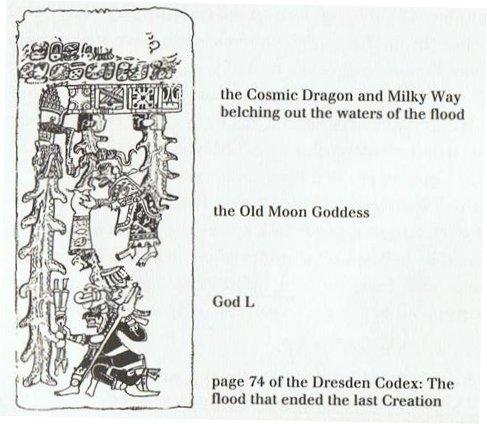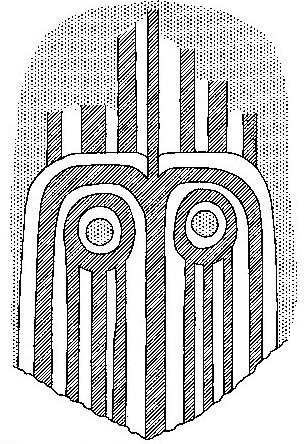Possibly Bb11-18 alluded to November 18 (11-18):
... the oak had made trouble right from the start. When (in the second rune of the Kalevala) Sämpsä Pellervöinen had sowed trees, it was the oak alone that would not grow until four or five lovely maidens from the water, and a hero from the ocean, had cleared the ground with fire and planted an acorn in the ashes; and once it had started, the growth of the tree could not be stopped: And the summit rose to heaven // And its leaves in air expanded, // In their course the clouds it hindered, // And the driving clouds impeded, // And it hid the shining sunlight, // And the gleaming of the moonlight. Then the aged Vainamoinen, // Pondered deeply and reflected, // 'Is there none to fell the oak-tree, // And o'erthrow the tree majestic? // Sad is now the life of mortals, // And for fish to swim is dismal, // Since the air is void of sunlight, // And the gleaming of the moonlight.' 'One sought above in the sky, below in the lap of the earth', as we are informed by variants, but then Vainamoinen asked his devine mother for help. Then a man arose from ocean // From the waves a hero started, // Not the hugest of the hugest, // Not the smallest of the smallest. // As a man's thumb was his stature; // Lofty as the span of woman. The 'puny man from the ocean', whose 'hair reached down to his heels, the beard to his knees', announces, 'I have come to fell the oak tree / And to splinter it to fragments'. And so he does. In several variants the oak is said to have fallen over the Northland River, so as to form the bridge into the abode of the dead. Holmberg (quoted by Lauri Honko, 'Finnen', Wb. Myth., p. 369) took the oak for the Milky Way ...
The 'Small Eyes' as the name for the Pleiades cluster could have been created in order to refer to the 6 stars (Tau-ono) rising heliacally in day 135 (May 15, 500). ... A sidelight falls upon the notions connected with the stag by Horapollo's statement concerning the Egyptian writing of 'A long space of time: A Stag's horns grow out each year. A picture of them means a long space of time.' Chairemon (hieroglyph no. 15, quoted by Tzetzes) made it shorter: 'eniautos: elaphos'. Louis Keimer, stressing the absence of stags in Egypt, pointed to the Oryx (Capra Nubiana) as the appropriate 'ersatz', whose head was, indeed, used for writing the word rnp = year, eventually in 'the Lord of the Year', a well-known title of Ptah. Rare as this modus of writing the word seems to have been - the Wörterbuch der Aegyptischen Sprache (eds. Erman and Grapow), vol. 2, pp. 429-33, does not even mention this variant - it is worth considering (as in every subject dealt with by Keimer), the more so as Chairemon continues his list by offering as number 16: 'eniautos: phoinix', i.e., a different span of time, the much-discussed 'Phoenix-period' (ca. 500 years) ...
135 + 183 = 318 (683). Metoro could therefore (11-18 → November 18) have stated that here began the Little Man (Tagata itiiti), possibly influenced by the idea of One and Seven. ... The father does not disappear, but goes on being fulfilled. Neither dimmed nor destroyed is the face of a lord, a warrior, craftsman, an orator. Rather, he will leave his daughters and sons. So it is that I have done likewise through you. Now go up there on the face of the earth; you will not die. Keep the word. So be it, said the head of One and Seven Hunaphu - they were of one mind when they did it ... Counting 10 days ahead from Bb11-18 will bring us to Bb11-28, and then the assumed 22 (= 3.14 * 7) days for the cycle of Lono should bring us to the day before the solstice. Let's do this excercise and see what we can learn!
'November 28 (332) should have changed to day 332 + 27 = 359 (December 25) in rongorongo times, but the creator of the B text could have used some other frame of reference, with Splashing Water not in day 354 ('December 20) but in day 333. Or he could at this place have ignored the cycle of Lono. Metoro repeatedly cautioned hia (count!). "Hiatus... gap, chasm XVI; interruption of continuity XVII; break between two vowels XVIII. - L. hiātus gaping, opening, f. hiāre gape (cf. dawn)." (English Etymology)
In 'December 20 (354) was Splashing Water. But maybe it could have been already in 'November 29 (333 = 666 / 2). For here the creator of the G text seems to have illustrated a fall of water,
with Metoro making clear this was the place for hopu. ... in the ceremonial course of the coming year, the king is symbolically transposed toward the Lono pole of Hawaiian divinity ... It need only be noticed that the renewal of kingship at the climax of the Makahiki coincides with the rebirth of nature. For in the ideal ritual calendar, the kali'i battle follows the autumnal appearance of the Pleiades, by thirty-three days - thus precisely, in the late eighteenth century, 21 December, the winter solstice. The king returns to power with the sun. Whereas, over the next two days, Lono plays the part of the sacrifice. The Makahiki effigy is dismantled and hidden away in a rite watched over by the king's 'living god', Kahoali'i or 'The-Companion-of-the-King', the one who is also known as 'Death-is-Near' (Koke-na-make). Close kinsman of the king as his ceremonial double, Kahoali'i swallows the eye of the victim in ceremonies of human sacrifice ... In the deep night before the image [of Lono] is first seen, there is a Makahiki ceremony called 'splashing-water' (hi'uwai). Kepelino tells of sacred chiefs being carried to the water where the people in their finery are bathing; in the excitement created by the beauty of their attire, 'one person was attracted to another, and the result', says this convert to Catholicism, 'was by no means good'. At dawn, when the people emerged from their amorous sport, there standing on the beach was the image of Lono. White tapa cloth and skins of the ka'upu bird hang from the horizontal bar of the tall crosspiece image. The ka'upu is almost certainly the albatross, a migratory bird that appears in the western Hawaiian chain - the white Lanyon albatross at Ni'ihau Island - to breed and lay eggs in October-November, or the beginning of the Makahiki season ...
Matagi means wind, which should dry up the water, but ma-tagi means 'with tears'. It could have been a word-play.
Anyhow, the antagonism between rain (ua) - the Water Serpent - and the wind (matagi), presumably representing the Sun King, here becomes evident. There was a Battle for the King at the solstice. ... A vestige of the practice of putting the king to death at the end of a year's reign appears to have survived in the festival called Macahity, which used to be celebrated in Hawaii during the last month of the year. About a hundred years ago a Russian voyager described the custom as follows: 'The taboo Macahity is not unlike to our festival of Christmas. It continues a whole month, during which the people amuse themselves with dances, plays, and sham-fights of every kind. The king must open this festival wherever he is. On this occasion his majesty dresses himself in his richest cloak and helmet, and is paddled in a canoe along the shore, followed sometimes by many of his subjects. He embarks early, and must finish his excursion at sunrise. The strongest and most expert of the warriors is chosen to receive him on his landing. The warrior watches the canoe along the beach; and as soon as the king lands, and has thrown off his cloak, he darts his spear at him, from a distance of about thirty paces, and the king must either catch the spear in his hand, or suffer from it: there is no jesting in the business. Having caught it, he carries it under his arm, with the sharp end downwards, into the temple or heavoo. On his entrance, the assembled multitude begin their sham-fights, and immediately the air is obscured by clouds of spears, made for the occasion with blunted ends. Hamamea (the king) has been frequently advised to abolish this ridiculous ceremony, in which he risks his life every year; but to no effect. His answer always is, that he is as able to catch a spear as any one on the island is to throw it at him ... The pu (hole) type of glyph (Bb11-39) could possibly depict the dry Land ruled over by the Sun king, beginning at spring equinox (dawn) and ending at dusk (autumn equinox). The Sun dried away all the rain because a wind of changes was brought about from his heat. Then Saturn ('dripping water')
intervened and returned it all to the pristine origin, where / when once again Rain would join Father Sky and Mother Earth in a close embrace.
There were 49 days (7 weeks) from Bb11-39 to the end of the text on side b, and 39 (as in Bb11-39) + 49 = 88, which could be significant:
|
|||||||||||||||||||||||||||||||||||||||||||||||||||||||||||||||||||||||||||||||||||||||||||||||||||||||||||||||||||||||||||||||||||||||||||||||||||||||||||||||||||||||||

























